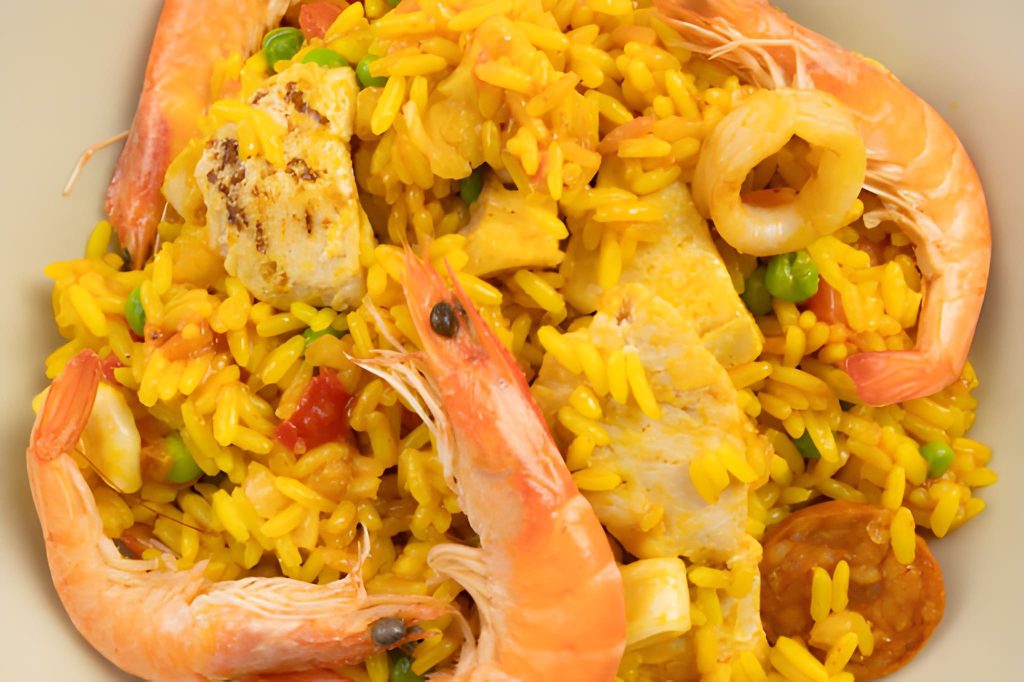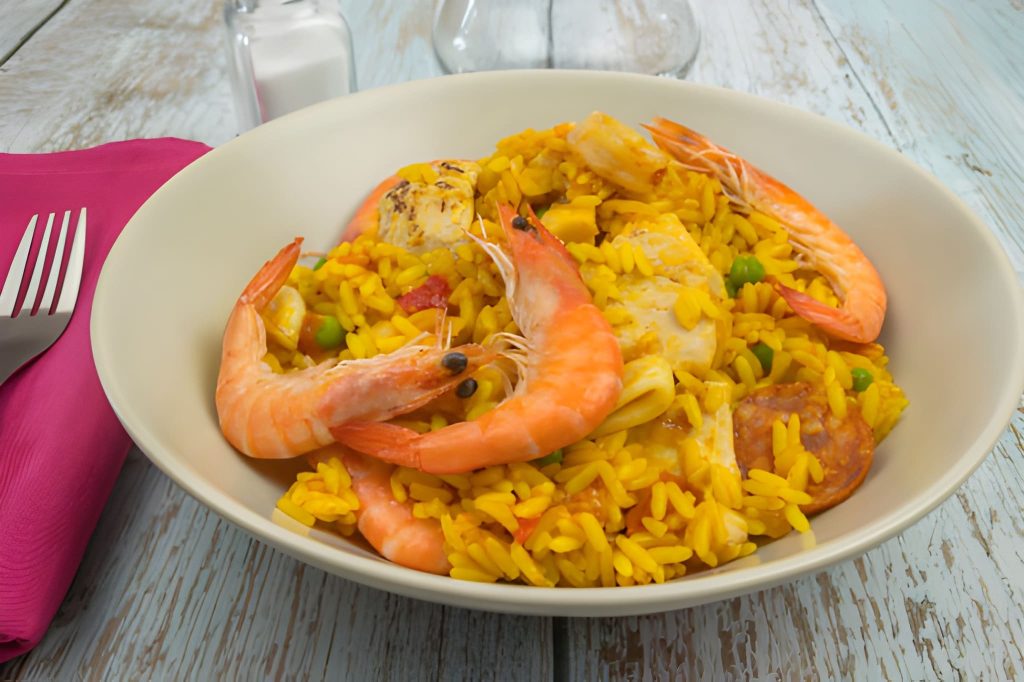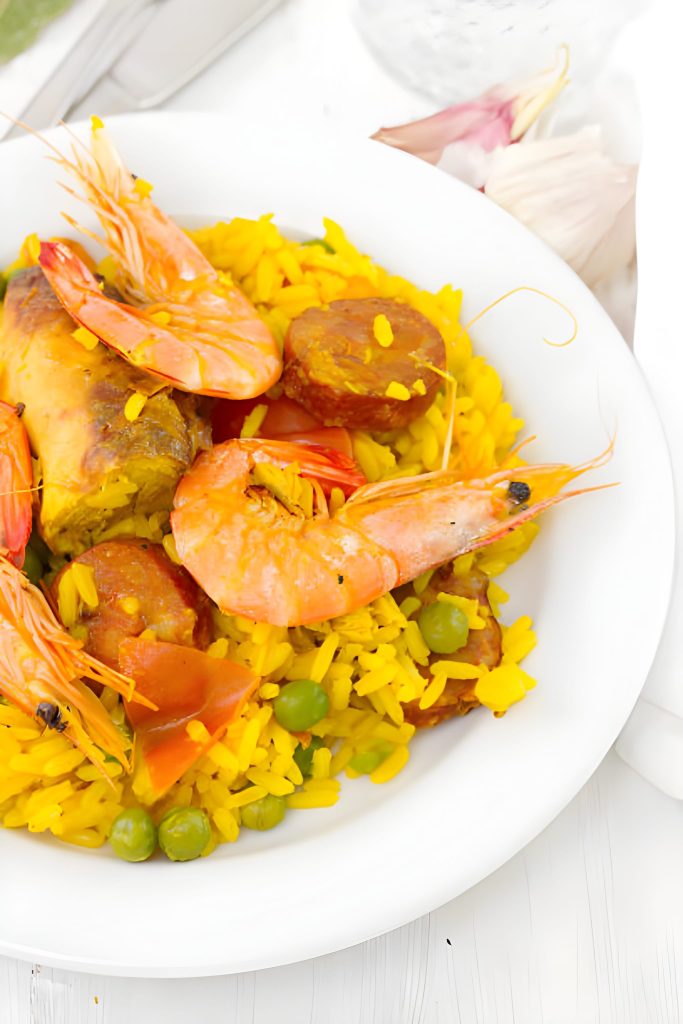Spanish Paella Recipe
Spanish Paella is a masterpiece of color, aroma, and taste—an iconic dish that captures the heart of Spanish coastal cooking. It’s a celebration of bold flavors and rustic charm, where tender chicken, plump prawns, briny mussels, and smoky chorizo come together over golden saffron rice. Each layer builds depth and character, resulting in a vibrant, family-style meal that’s as beautiful to present as it is satisfying to eat. This is comfort food infused with Mediterranean sunshine, perfect for sharing around a lively table.

Ingredient Breakdown
At the foundation of any good paella lies the rice. Traditional varieties like Bomba, Calasparra, or Valencia are chosen for their unique ability to absorb liquid while keeping a firm, separate grain. They create that perfect, slightly chewy texture that holds up under rich broth and savory toppings. A robust stock—whether chicken or seafood—infuses each grain with flavor, while saffron threads tint the rice a radiant golden hue and fill the air with their distinct, earthy fragrance.
The proteins play equally essential roles. Chicken thighs add richness and succulence that complement the deep, smoky notes of sliced chorizo, while prawns and mussels introduce sweetness from the sea. Squid brings tenderness and subtle brininess, enhancing the dish’s maritime character. Together, they create a harmonious balance of land and sea.
The aromatic base begins with onion, garlic, and red bell pepper—an aromatic medley that softens into a sweet, flavorful sofrito. This foundation enriches the rice and provides layers of complexity. Saffron, with its floral undertones, and chorizo, with its smoky paprika, elevate the dish, adding color and dimension that define authentic Spanish flavor. Finally, a handful of parsley and a squeeze of lemon bring freshness that brightens every bite, cutting through the richness and uniting all elements beautifully.
Step-by-Step Preparation Guide
The first step is to build depth through searing. The chorizo is browned until crisp, releasing flavorful oils that set the tone for the rest of the dish. The squid follows briefly, caramelizing on the edges without becoming rubbery. Each protein adds its own character to the pan, layering savory essence into the base.
Next comes the sofrito—the aromatic backbone of paella. Garlic and onion sizzle in the seasoned oil, filling the kitchen with an inviting fragrance. The diced bell pepper joins in, softening into a sweet base that anchors the dish. This foundation ensures that every bite of rice carries depth and warmth.
The rice is then stirred into the pan, allowing it to toast lightly and absorb the flavors of the oil. Once glistening and aromatic, a combination of broth, tomatoes, saffron, and chorizo is introduced, infusing the dish with rich color and flavor. At this stage, the mixture simmers gently without interference—this stillness allows the rice to cook evenly and begin forming the prized socarrat, a golden, crispy crust at the bottom of the pan that paella lovers treasure.
As the broth reduces, the prawns, mussels, and peas are nestled into the rice. The seafood cooks gently in the aromatic steam until the prawns turn a vivid pink and the mussels open, signaling perfection. Once the liquid is mostly absorbed, the pan is removed from the heat. Resting the paella for a few minutes allows the rice to absorb any remaining moisture, resulting in a tender yet slightly firm texture. Garnishing with fresh parsley and lemon wedges completes the dish, making it ready to serve straight from the pan—a visual and aromatic feast.

Recipe Tips & Frequently Asked Questions
Choosing the right rice variety for authentic results:
Use short-grain Spanish rice such as Bomba or Calasparra for ideal absorption and texture.
Balancing liquid levels:
Maintain the correct broth-to-rice ratio; too much liquid makes the dish soupy, too little leaves it undercooked.
Achieving the perfect socarrat:
Avoid stirring once the rice begins simmering; the stillness helps form the crispy, caramelized bottom layer.
Adjusting proteins:
Substitute seafood or meat based on availability, but balance their cooking times to prevent overcooking.
Saffron alternatives:
For a budget-friendly option, use a pinch of turmeric and smoked paprika to mimic color and aroma.
Can I use regular rice instead of paella rice?
Short-grain rice like arborio works in a pinch, but it won’t achieve the same firm texture or absorbency.
What’s the best way to ensure mussels open properly?
Make sure they’re fresh and scrubbed clean; discard any that remain closed after cooking.
Can I make paella without seafood?
Absolutely—simply use chicken and chorizo, or add vegetables for a land-based variation.
How do I prevent the rice from sticking too much?
Keep the heat moderate during simmering and avoid stirring once the liquid has been added.
Is it possible to reheat paella without drying it out?
Sprinkle a little water or broth over it and reheat gently on the stove or in the oven, covered with foil.
What to Serve With This Recipe
Paella is rich and hearty, so simple accompaniments enhance the meal without overpowering it. Crusty bread brushed with olive oil and rubbed with garlic is a classic choice that complements the saffron-infused rice. A side of crisp green salad or roasted vegetables provides freshness and color balance. For an authentic Spanish touch, serve small bowls of marinated olives or patatas bravas. To complete the experience, pour glasses of chilled white wine, sparkling water with lemon, or a refreshing sangria—the perfect companions to this sun-soaked feast.
Creative Variations
Paella is endlessly versatile. For a rustic countryside twist, swap the chicken for rabbit or duck, adding a deeper, gamey flavor. Vegetarians can create a stunning version filled with artichokes, beans, zucchini, and roasted peppers for a colorful, plant-forward feast. Seafood lovers might explore coastal-style paellas with clams, scallops, or even lobster for a luxurious edge. The beauty of paella lies in its adaptability—it can be as humble or as grand as the occasion demands.
Spanish Paella is a dish of harmony—where sea meets land, and simplicity meets sophistication. Its golden rice, smoky chorizo, and tender seafood embody the warmth and generosity of Mediterranean cooking. Shared directly from the pan at the center of the table, it invites conversation, laughter, and connection. Every spoonful carries a taste of Spain’s sunlit coasts, turning an ordinary meal into a celebration of flavor and tradition.

Ingredients
1½ cups paella rice (“Bomba,” “Valencia,” or “Calasparra”) (Note 3)
300g / 10 oz chicken thigh fillets, cut into bite-sized 1.5″ / 3.5cm pieces
7 oz / 200g chorizo (about 2 links), sliced into ½ cm / ⅕” thick rounds (Note 1)
12–16 medium or large prawns, shell-on (Note 7)
12 large mussels, cleaned and checked for freshness (Note 8)
200g / 6 oz squid (calamari), sliced into 7mm / ¼” thick rings (Note 2)
1 onion, finely diced (brown, white, or yellow)
1 red bell pepper (capsicum), diced
3 garlic cloves, minced
2 juicy ripe tomatoes, peeled and diced, or ¾ cup canned crushed tomatoes (Note 4)
3½ cups chicken broth or homemade seafood stock (avoid low-sodium) (Note 5)
1 teaspoon saffron threads, or ¼ teaspoon ground saffron (Note 6)
1 cup frozen peas
1–2 tablespoons olive oil
Fresh parsley, chopped (for garnish)
2 lemons, cut into wedges (for serving)
Instructions
Begin by heating 1 tablespoon of olive oil in a 30 cm / 10-inch paella pan or a wide, heavy skillet over high heat (Note 9). Add the sliced chorizo and cook for about 3 minutes, turning occasionally until both sides are crisped and lightly browned. Using a slotted spoon, remove the chorizo and set it aside, leaving the flavorful oil in the pan.
Next, add the squid to the hot pan and sear for about 45 seconds per side, just until lightly golden and opaque. Transfer the squid to a plate and set aside.
If the pan looks dry, drizzle in a bit more olive oil. Add the minced garlic and diced onion, sautéing for about 2 minutes until fragrant and translucent. Stir in the diced red bell pepper and cook for another minute to soften.
Add the chicken pieces to the mixture and cook for about 2 minutes, allowing the meat to take on light color while remaining undercooked inside. Stir in the rice, coating each grain in the aromatic oil and pan juices—this step helps lock in flavor and gives the paella its signature texture.
Pour in the chicken broth, diced or crushed tomatoes, saffron, and most of the browned chorizo, reserving a small portion for garnish later. Stir gently to combine, ensuring the rice is evenly distributed. Bring the mixture to a steady simmer, then reduce the heat to maintain a gentle bubbling surface. Allow it to cook uncovered for 10 minutes without stirring—this helps form the prized socarrat, a golden, crispy layer of rice at the bottom of the pan.
After 10 minutes, scatter the frozen peas over the surface and gently nestle the prawns and mussels into the rice, leaving some exposed for an appetizing presentation. Continue cooking for about 8 minutes, turning the prawns halfway through if needed. The prawns should turn pink and opaque, the mussels should open, and the liquid should mostly absorb while remaining slightly moist. Discard any mussels that stay closed.
Taste a few grains of rice—it should be firm yet tender. If it feels too firm, splash in a bit of hot water and cook for a few extra minutes. Once the texture is just right, remove the pan from the heat. Arrange the cooked squid and reserved chorizo over the top. Cover with a lid and let the paella rest for 5 minutes, allowing the rice to finish absorbing the last of the flavorful liquid.
The rice should be tender yet loose and glistening—not thick or sticky. If needed, add a small splash of water to loosen the texture. Finally, sprinkle with chopped parsley and garnish with lemon wedges. Serve the paella directly from the pan, stirring the rice and seafood together at the table for a rustic, authentic presentation.

Spanish Paella Recipe
Ingredients
- 1½ cups paella rice “Bomba,” “Valencia,” or “Calasparra” (Note 3)
- 300 g / 10 oz chicken thigh fillets cut into bite-sized 1.5″ / 3.5cm pieces
- 7 oz / 200g chorizo about 2 links, sliced into ½ cm / ⅕” thick rounds (Note 1)
- 12 –16 medium or large prawns shell-on (Note 7)
- 12 large mussels cleaned and checked for freshness (Note 8)
- 200 g / 6 oz squid calamari, sliced into 7mm / ¼” thick rings (Note 2)
- 1 onion finely diced (brown, white, or yellow)
- 1 red bell pepper capsicum, diced
- 3 garlic cloves minced
- 2 juicy ripe tomatoes peeled and diced, or ¾ cup canned crushed tomatoes (Note 4)
- 3½ cups chicken broth or homemade seafood stock avoid low-sodium (Note 5)
- 1 teaspoon saffron threads or ¼ teaspoon ground saffron (Note 6)
- 1 cup frozen peas
- 1 –2 tablespoons olive oil
- Fresh parsley chopped (for garnish)
- 2 lemons cut into wedges (for serving)
Instructions
- Begin by heating 1 tablespoon of olive oil in a 30 cm / 10-inch paella pan or a wide, heavy skillet over high heat (Note 9). Add the sliced chorizo and cook for about 3 minutes, turning occasionally until both sides are crisped and lightly browned. Using a slotted spoon, remove the chorizo and set it aside, leaving the flavorful oil in the pan.
- Next, add the squid to the hot pan and sear for about 45 seconds per side, just until lightly golden and opaque. Transfer the squid to a plate and set aside.
- If the pan looks dry, drizzle in a bit more olive oil. Add the minced garlic and diced onion, sautéing for about 2 minutes until fragrant and translucent. Stir in the diced red bell pepper and cook for another minute to soften.
- Add the chicken pieces to the mixture and cook for about 2 minutes, allowing the meat to take on light color while remaining undercooked inside. Stir in the rice, coating each grain in the aromatic oil and pan juices—this step helps lock in flavor and gives the paella its signature texture.
- Pour in the chicken broth, diced or crushed tomatoes, saffron, and most of the browned chorizo, reserving a small portion for garnish later. Stir gently to combine, ensuring the rice is evenly distributed. Bring the mixture to a steady simmer, then reduce the heat to maintain a gentle bubbling surface. Allow it to cook uncovered for 10 minutes without stirring—this helps form the prized socarrat, a golden, crispy layer of rice at the bottom of the pan.
- After 10 minutes, scatter the frozen peas over the surface and gently nestle the prawns and mussels into the rice, leaving some exposed for an appetizing presentation. Continue cooking for about 8 minutes, turning the prawns halfway through if needed. The prawns should turn pink and opaque, the mussels should open, and the liquid should mostly absorb while remaining slightly moist. Discard any mussels that stay closed.
- Taste a few grains of rice—it should be firm yet tender. If it feels too firm, splash in a bit of hot water and cook for a few extra minutes. Once the texture is just right, remove the pan from the heat. Arrange the cooked squid and reserved chorizo over the top. Cover with a lid and let the paella rest for 5 minutes, allowing the rice to finish absorbing the last of the flavorful liquid.
- The rice should be tender yet loose and glistening—not thick or sticky. If needed, add a small splash of water to loosen the texture. Finally, sprinkle with chopped parsley and garnish with lemon wedges. Serve the paella directly from the pan, stirring the rice and seafood together at the table for a rustic, authentic presentation.

